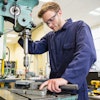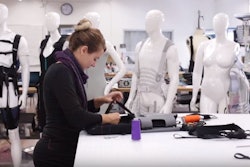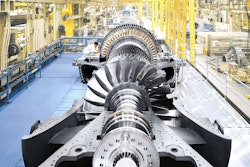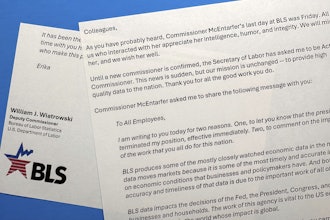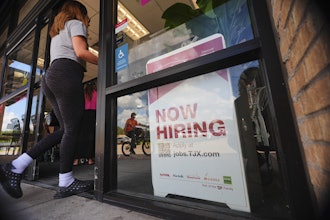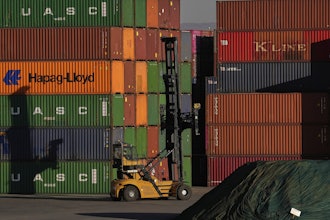With 2018 now here, manufacturing executives are looking toward new operational possibilities to ring in the new year. With that in mind, IMPO recently spoke with senior vice president of operations at The Raymond Corporation, Rick Harrington, on manufacturing workforce development and how companies can rise to the challenge.
IMPO: What are the biggest challenges manufacturing companies face today regarding their workforce?
Rick Harrington: There are two big challenges facing today’s manufacturing companies: lack of new employees’ basic manufacturing skills and the desire for flexible work environments.
More and more, new employees who are starting manufacturing jobs are lacking basic mechanical skills. These skills range from the ability to use a torque wrench to how to use measuring devices. In the past, these types of skills were much more prevalent in the manufacturing workforce. Today, however, developing these skills is just not part of everyday life anymore.
With today’s young workforce, we’ve seen a change in lifestyles and backgrounds. Fewer people seem to be growing up on farms and working on equipment as a means of living, as well as passing the time. This workforce also tends to be more engaged with different interests, such as organized sports and gaming. In addition, a lot of the technology ingrained in today’s machines prevents people from taking apart cars, for example, and putting them back together. The easy-to-work-on cars of the past are no longer an option for the hobbyist who has access only to new, technologyforward cars. The same goes for the technologically advanced manufacturing machinery, too.
In addition, the desire for flexible work environments, especially as it pertains to schedules, is becoming a challenge for manufacturing companies. There seems to be quite a movement away from historically rigid, structured workdays to much more flexible type of work environments with atypical shifts. For the manufacturing industry, this is a 180-degree shift from what has been the standard. Typically, manufacturing companies want the same thing for their employees day after day — for them to show up same time, be on the line for a set time period and go home at the same time each day. The challenge for manufacturing companies will be to determine how to run an assembly line while accommodating flexible schedules.
IMPO: What are your predictions for advancements in factory automation for 2018 or the following couple years?
Harrington: Through 2018 and beyond, the industry will continue to see an increase in automation in factories. Truly redundant and repetitive tasks — for example, transporting and transitioning materials throughout a warehouse — will be automated through means such as AGVs, or automated guided vehicles. Robotic machinery will continue to become prevalent in factory settings as well, which will help workplace efficiency and an increased bottom line.
For example, at Raymond’s Greene, NY facility, a robotic welder has been installed in the welding station. The company chose to implement this machinery on account of often needing miles and miles of welding to be done each day. It’s important to note that Raymond didn’t make this change to purposely replace a person with a robot, but to instead relieve needing to have an employee do extremely physically demanding and difficult tasks, such as welding thousands of feet during a shift.
By automating redundant and sometimes tremendously demanding tasks, employees will be able to focus their time and skillsets on value-added positions. More and more new-to-the-workforce employees are wanting to take on roles that add value, rather than be tasked with redundant movements throughout a workday.
IMPO: How can companies combat the challenge of developing a workforce?
Harrington: In a nutshell, companies can combat the challenge of developing a workforce by eliminating hard work, serving as responsible teachers and trainers and collaborating with educational institutions to introduce manufacturing early on and set expectations.
One thing companies can do is to work toward eliminating difficult work. The Japanese call this YK Work.
For example, this could be needing to access an area to secure a hard-to-install bolt, or a process that includes moving heavy objects repeatedly. Companies will want to look at their workforce opportunities, on account that everyone should have an equal opportunity to be successful in their position — no matter their size or strength. Implementing processes that allow anyone to be successful and comfortable in their role will help ensure a dedicated and happy workforce.
Another area in which companies can combat the challenge of developing a workforce is by being more responsible teachers and trainers. At Raymond, the company offers dojos, or areas in which employees can learn a skill before employing it on the shop floor. For example, the company offers assembly and welding dojos, to name a few, where new employees with little to no experience can learn and practice the skills Raymond expects them to attain that is not under a timeclock or fast-moving, production-type environment. These dojo experiences allow them to digest what is expected, practice and remember it — in a less demanding environment. It’s a big responsibility for manufacturers to be world-class teachers and trainers.
Lastly, companies also need to consider collaborating with local or applicable schools and educational programs as much as possible. This could include high schools, local universities and technical schools. Through these types of programs, companies can find potential candidates and help set, early on, the expectations for what the employee would get hired on to do. This collaboration and experience helps prepare them early on instead of being surprised by the work requirements once on the job.
IMPO: We hear a lot about the fear in manufacturing that technology will replace human workers. What new technologies do you think will be available in 2018, and what ways could technology be used to help develop a workforce, as opposed to replacing it?
Harrington: The Internet of Things (IoT) and Manufacturing 4.0 (Industry 4.0), will continue to be at the forefront of the manufacturing industry. With these approaches, the push for interconnectivity from machine-to-machine and machine-to-human will be on the rise. Today’s machines that take on a lot of work and can even talk — calling out when they need service, for example — still require humans who can attend to them and work with them to ensure efficient and effective operations. Humans and machines will need to work together to discern how the vast amount of data being generated can be used most effectively.
IMPO: Anything else you would like to add?
Harrington: We’ve heard a lot about Millennials and how different their work style and attitude is from older generations. At the end of the day, however, their approach isn’t much different from previous up-and-coming generations that looked to do things differently than their predecessors.
This generation is highly interested in work-life balance and is much more socially diverse. Although they do often come in somewhat inexperienced, they’re very idealistic and will mature as they gain experience. After others recognize that this generation-to-generation head-butting is no different than in previous decades, manufacturing companies can be just as successful about bringing Millennials into the workforce just as it happened with other generations.

